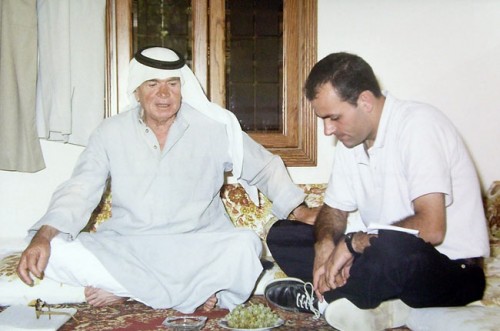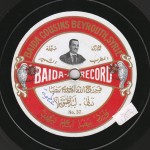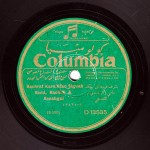The Arab Music Archiving and Research foundation (AMAR), in collaboration with the Sharjah Art Foundation (SAF), presents “Durūb al-Nagham”.
Dear listeners,
Welcome to a new episode of “Durūb al-Nagham”.
We will present today’s episode about Folk Music with Father Dr. Badih el-Hajj, Director of the Archiving and Documentation Department at the Holy Spirit University, who will tell us about Folk Music in Lebanon.
Welcome dear Father.
Hello Mr. Mustafa. I hope today’s episode will be beneficial to our listeners.
Thanks to your presence, may God protect you.
God protect you.
Let us start from the beginning with the shaping/formation phase of music.
It is difficult to talk about music’s shaping phase as we do not know how heritage music and folk music were formed in the beginning. Music, religious or folk, accompanies people all over the world from birth and throughout their life, to their grave –and it is not music just for the sake of music–: there are the cradle songs, the work songs, the wedding songs, and the grieving songs. It is difficult to talk about the origin of these musics.
The music in our region, i.e. the Levant or the Near-East, in Lebanon and its neighbouring countries is very similar: the types and styles of music in Jordan, Lebanon, Syria, and Palestine share similar characteristics.
That may also be shared by parts of Northern Iraq and the Sinai.
True. The old Syriac, Assyrian, and Acadian traditions in Iraq were the cradle of the Eastern civilisations at a specific point in time (Ancient History). We must also consider the exchange between North Egypt and Jordan that was not limited to the trade of merchandise but was extended to civilisation, culture, music, and songs.
Let us talk about the origins of Lebanese music. Lebanese music reflects Lebanon’s nature: the coast, i.e. the seashore on the Mediterranean, the mountain i.e. the Western Mountain Range reaching the sea, the Bekaa Valley between the Oriental and the Western Mountain Ranges characterised by a desert climate and that goes beyond the Oriental Mountain Range reaching the borders of Syria, Iraq, and the East of the desert.
This geographical variety has determined Lebanon’s music, civilisation, language and dialects, food, and way of life:
- Music in the coastal area came from cities through travelling, emigration, and trade. It includes Aleppan qadd-s (song in colloquial Arabic with a composed melody, of a simple or repetitive structure, in the Aleppan tradition and forming a continuum with the Egyptian taqṭūqa), Iraqi maqām (modal key) and Baghdadi mawwāl (poem in colloquial Arabic, sung in a non-metrical cantillatory form), and muwashshaḥ (plurimetric and plurirhyme Arabic poem) that also reached us through travelling and emigration but also through the peoples who governed our country, all this added to the influence of western music.
- The heritage traditional music in the mountain clearly shows the Syriac influence as the Syriac language was widespread in these villages, and folk poetry was sung following the Syriac cantillation (improvised recitation assigning melodic heights to the text’s syllables, while respecting its metric prosody). The styles we will listen to clearly illustrate the Syriac influence on mountain music.
- The Bedouin influence is very obvious in the plains or sahl It came from the East with the emigration of nomadic or seminomadic Bedouin –at a certain point in time, the nomadic Bedouins settled and built houses, and influenced/were influenced by the traditions in the Bekaa region, especially in Northern Bekaa that is close to the Syrian border.
By Bedouins you mean the nomadic Bedouins who settled and became shepherds.
Exactly. Those who became shepherds living from the milk and cheese of their sheep, and those who became farmers working for landowners in seasonal reaping …etc. Lately, many of those were granted the Lebanese citizenship: we consider them as Lebanese citizens from a foreign origin.
Let us also explain the difference between Gypsies (nūrī-s or nawar) and Bedouins: the Bedouins are Arabs whereas the Gypsies are not. These “Tziganes”, as they are called in French, are Indians who moved to Europe: there are the Doms in the East and the Roms in the West. They are to be approached from a different perspective and their heritage is very far from our musical heritage. Yet they do adapt, take our music and live through it, i.e. they sing it and live from it, but it is not their music.
Let us go back to the mountain. In the 11th / 12th / 13th century, many migrants including Arab tribes and those who believed in esoteric religions fled from the Central Government in Baghdad and came to Mount Lebanon. Did these migrations from the Arabian Peninsula to Mount Lebanon have an impact/influence?
Of course, In the Fatimid era and later, the Druzes who came to Lebanon through these migrations influenced our music, as well as our customs, traditions, and practices: music can’t be considered separately because it is practiced in weddings, or for example at the funeral of a young man where songs are performed in a certain manner, and where people yuḥawribūn (fight) for him. This word they use and have given us comes from “al-ḥawraba” whose origin is “ḥarb” (war), implying the fighting between tribes to keep the land they lived on, or for honour…etc. This heritage existed and had an impact. The Lebanese Heritage Music is a mix / blend in a melting pot, i.e. Lebanon, that led to this fusion that affected the musical civilisation and gave us the Lebanese Heritage Music. Still, there isn’t one Lebanese music: each region has its own way to perform and to practice.
The civilisations that came in the 12th century, including the Mamluks and the Crusaders (oriental and western influences) provoked migrations: for example, people fled from the mountains taking along with them their heritage, and settled. Note that the persecution helped in preserving the Lebanese heritage: not only was it enriched with the western influences, but the isolated living of those fleeing persecution allowed them to keep their heritage free from any foreign influence resulting from confluence and interaction with other peoples.
You mean that they feared extinction.
Exactly.
I am very eager to know about Ephrem the Syrian’s first hymns performed in the 4th century. Do they represent the first influence of Folk Music on religious music?
Ephrem the Syrian was preceded by Bardaisan in the 2nd century, i.e. the early Christian era when doctrines were marred with heresy. Bardaisan, a gnostic who thus believed that human beings could know God through a personal approach, was excommunicated. He is the one who started to affix religious poems onto folk melodies after noticing that the inhabitants of Rahā (in Turkey today) liked music, songs, and poetry. So, having failed to teach his doctrine there through preaching and convincing because the inhabitants were simple farmers who had no time to read or have a philosophy, and seeing that they sang during their celebrations, he affixed religious poems as well as poems that illustrated his doctrine onto their folk melodies, knowing that his doctrine went against orthodoxy, i.e. the adherence to the correct faith.
Ephrem the Syrian came 150 years later. He followed the same system, but the doctrinal influence of Bardaisan was still there. So, in order to erase it, he used the same weapons: he affixed onto existing folk melodies poems, sermons, and even prose (not poetry). These orally transmitted (there was no musical notation then) ifrāmiyyāt dedicated to the Virgin Mary, to the birth of Christ, or to the Passion of the Christ and his crucifixion, are still chanted today in churches. We were only able to find the scores of poems that remained after him.
We believe that his ifrāmiyyāt that are still chanted in churches transmitted the traditions, and affected the qerrādeh, the muwashshaḥ baladī and the mu‘anna, that are the Lebanese –mainly mountain– styles. Their poetic structure and melody clearly show Ephrem the Syrian’s Syriac influence.
The proof is that, until today, some melodies are used for both the mundane and the religious.
Exactly… Furthermore some of the Syriac folk melodies chanted in church can be used to dance dabka if accompanied by a percussion instrument. This will surely not happen because they are religious: I am not referring to the lyrics, but to the melody that is very close to the folkloric heritage melodies …
(♩)
Would you like us to start our journey with the forms following the regions or not?
We can talk about both. The Lebanese Heritage Musical Forms can be separated into two main categories: those who reached us from the East, and those existing in the mountain. The heritage reached the coastal areas through the migration from the plain and the mountain. ‘Atābā (folk monadic song in colloquial Arabic), dabka or dal‘ōna only reached Beirut lately with the migration to the coast …
(♩)
Let us make the distinction between long songs, i.e. mawwāl and qaṣīda singing, and the songs performed to the dabka rhythm and the Lebanese folk dances). Studies, history, and writings have showed that the ‘atābā, a very well-known long song whose origin is not Lebanese, started in Iraq and reached the Lebanese territory through Syria, via Baalbeck.
Let me tell you the beautiful tale about a member of the nobility, Ibrāhīm al-Fāḍil, who was struck with smallpox and was thus exiled from his clan who feared contagion. He crossed the deserts and reached Lebanon, full of reproach (‘itāb) against his tribe. He told his story in a qaṣīda (monometric and monorhyme poem in classical Arabic) that is still sung in Lebanon, Syria, and the Iraqi border, and that relates the story of the ‘atābā.
We will listen to a type of ‘atābā sung until today by the Ṭayy tribe in Northern Syria at the Iraqi border. I recorded their ‘atābā singing to show that “ ‘atābā” is a shared appellation and poetry form onto which we all affix jinās (paronomasia), four hemistiches …etc., and where the melody, the way to perform, the voice, and the articulation of sound change from one country to another and from one region to another inside the same country.
The origin of ‘atābā is not Lebanese. The ‘atābā sung in Lebanon today is Lebanese, the ‘atābā sung in Syria is Syrian, and the ‘atābā sung by Bedouins is Bedouin. Here, its performance, melody, music composition, and the way to sing it took on Lebanese traits. Everywhere, the ‘atābā is to the maqām bayyātī when it is sung in the usual way, i.e. not in the sad way when it is called furūqiyyāt and is to the maqām ḥijāz that conveys sadness.
Sorrow.
Yes. There are sound samples we could listen to:
- Here is how the Lebanese Bekaa Bedouins we talked about sing it, accompanied by the rabāba (spike fiddle whose front is covered with sheepskin) …
(♩)
- There are other styles that are also sung to the maqām bayyātī or rather the jins (set of notes forming the basic pattern in Arab music) bayyātī as there is no maqām because the scale is short …
(♩)
- Here is a sample of the origin of the ‘atāba performed by the Ṭayy tribe so that our listeners can have an idea of how the ‘atāba was sung originally …
(♩)
Dear listeners,
We have reached the end of today’s episode of “Durūb al-Nagham” presented with Father Dr. Badih al-Hajj.
We will meet again in a new episode to resume our discussion about Folk Music in Lebanon.
“Durūb al-Nagham”.
- 221 – Zakariyya Ahmed – 12 (1/9/2022)
- 220 – Zakariyya Ahmed – 11 (1/9/2022)
- 219 – Zakariyya Ahmed – 10 (11/25/2021)
- 218 – Zakariyya Ahmed – 9 (10/26/2021)
- 217 – Zakariyya Ahmed – 8 (9/24/2021)
- 216 – Zakariyya Ahmed – 7 (9/4/2021)
- 215 – Zakariyya Ahmed – 6 (8/28/2021)
- 214 – Zakariyya Ahmed – 5 (8/6/2021)
- 213 – Zakariyya Ahmed – 4 (6/26/2021)
- 212 – Zakariyya Ahmed – 3 (5/27/2021)
- 211 – Zakariyya Ahmed – 2 (5/1/2021)
- 210 – Zakariyya Ahmed – 1 (4/28/2021)
- 209 – W-al-Lāhi lā astaṭī‘u ṣaddak 2 (4/6/2017)
- 208 – W-al-Lāhi lā astaṭī‘u ṣaddak 1 (3/30/2017)
- 207 – Bashraf qarah baṭāq 7 (3/23/2017)



